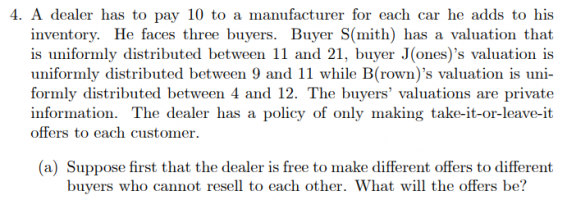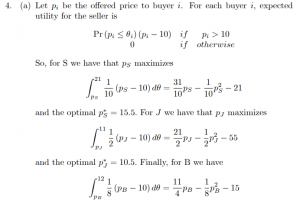You are using an out of date browser. It may not display this or other websites correctly.
You should upgrade or use an alternative browser.
You should upgrade or use an alternative browser.
Where do these integrals come from?
- Thread starter moogle12
- Start date
BigBeachBanana
Senior Member
- Joined
- Nov 19, 2021
- Messages
- 2,181
Recall the PDF of a uniform distribution is [imath]f(x)=\frac{1}{b-a}[/imath]. So for Smith, his PDF is [imath]f(p_s)=\frac{1}{21-11}=\frac{1}{10}[/imath].View attachment 33363
View attachment 33364
I know that integrating a PDF gives a CDF. I feel like that plays some role here. But I still don't understand where the intergrals come from here. Could someone explain?
Thanks
The integral is just calculating the expected value of Smith's offer minus the $10 the dealer has to pay the manufacturer.
[math]E(p_s-10)=\int_{p_s}^{21} (p_s-10)\cdot f(p_s)\,d\theta=\int_{p_s}^{21} (p_s-10)\cdot \frac{1}{10} \, d\theta[/math]
The rest are similar.
BBB has explained the mathematics, but the mathematics do not explain the economics.
Let’s start with a simpler problem. Car dealer (D) estimates subjectively that there is an equal probability that potential buyer Smith (S) has the following reserve prices (maximum price at which S will buy): 11, 13.5. 16, 18.5, and 21. Five numbers, equidistant and equiprobable.
It should be obvious that an offer to sell by D is not economically rational if it is anything other than one of those five numbers. In other words, x will not be less than 11 nor more than 21. We now see where the limits of integration come from. They come from economic reasoning about the situation.
Let x be the offer price and y be the unknown reserve price. Then we can compute the expected profit for each rational value of x as follows:
[math] 0 * \text {Probability}(y < x) * 0 + \text {Probability}(y \ge y) * (x-10) =\\ (x-10) * \sum_{j=1}^m \text {Probability}(y = x + (j – 1) * 2.5) = (x-10) * \dfrac{1}{5} * \sum_{j=1}^m 1 = (x – 10) * 0.2m. [/math]
And m = 5 if x = 11, m = 4 if x = 13.5, m = 3 if x = 16, m = 2 if x = 18.5, and m = 1 if x = 21.
The expected profits are accordingly
1 if x = 11
2.8 if x = 13.5
3.6 if x = 16
3.4 if x = 18.5
2.2 if x = 21
So D should offer to sell at 16.
But there is absolutely no reason to believe that D does not have 101 equally spaced reserve points, starting at 11.0, 11.1, … 20.8, 20.9, 20.0. And if that is so, an offer of 15.5 or 15.6 is optimal rather than 16. We do not know how many possible reserve prices to contemplate. Or we could go 11.00, 11.01, … 20.98, 20.99, 21.00. Let’s try to generalize. Let integer n > 1 be the number of conceivable reserve prices. They are equiprobable so the probability of guessing the true reserve price is 1/n instead of 1/5. But now we need to think more deeply about that sum.
Let d be the equal distance between possible reserve prices. Use the fencepost principle.
[math]d = \dfrac{21 - 11}{n - 1} = \dfrac{10}{n - 1}. [/math]
Notice that that works for our easy example. When n = 5, d = 2.5. So, what is m? Use the fencepost principle again.
[math]m = \dfrac{21 - x}{d} + 1 = \dfrac{21 - x}{1} * \dfrac{n - 1}{10} + 1 =\\ \dfrac{21n-21-nx + x}{10} + 1 = \dfrac{n(21- x)-21+x + 10}{10} = \dfrac{n(21-x)+(x -11)}{10}.[/math]
You can check that works for our simple example. If x = 16, 5(21 - 16) = 25, (16 -11) = 5, and (25+5)/10 = 3.
So, our formula generalizes to
[math](x-10) * \dfrac{1}{n} * \dfrac{n(21-x) + (x-11)}{10} = \dfrac{(x-10)(21-x)}{10} + \dfrac{(x-10)(x-11)}{10n} =\\ \dfrac{1}{10} * \left ( 31x - x^2 - 210 + \dfrac{x^2 - 21x + 110}{n} \right ) .[/math]
That is pretty ugly. But if you test against the n = 5 case, you will see it too works.
But we have no clue what n is. Let n go toward infinity.
[math]\lim_{n\rightarrow \infty} \dfrac{1}{10} * \left ( 31x - x^2 - 210 + \dfrac{x^2 - 21x + 110}{n} \right ) = 31x - x^2 – 210.[/math]
And that is a differentiable function of x because the differences in the reserve prices are now infinitesimal. Setting the derivative to zero gives 2x = 31 or x = 15.5.
We get integrals because we are taking the limit of a sum to find our differentiable function. And we use integrals because it is a whole lot faster than going through the agonies above.
Let’s start with a simpler problem. Car dealer (D) estimates subjectively that there is an equal probability that potential buyer Smith (S) has the following reserve prices (maximum price at which S will buy): 11, 13.5. 16, 18.5, and 21. Five numbers, equidistant and equiprobable.
It should be obvious that an offer to sell by D is not economically rational if it is anything other than one of those five numbers. In other words, x will not be less than 11 nor more than 21. We now see where the limits of integration come from. They come from economic reasoning about the situation.
Let x be the offer price and y be the unknown reserve price. Then we can compute the expected profit for each rational value of x as follows:
[math] 0 * \text {Probability}(y < x) * 0 + \text {Probability}(y \ge y) * (x-10) =\\ (x-10) * \sum_{j=1}^m \text {Probability}(y = x + (j – 1) * 2.5) = (x-10) * \dfrac{1}{5} * \sum_{j=1}^m 1 = (x – 10) * 0.2m. [/math]
And m = 5 if x = 11, m = 4 if x = 13.5, m = 3 if x = 16, m = 2 if x = 18.5, and m = 1 if x = 21.
The expected profits are accordingly
1 if x = 11
2.8 if x = 13.5
3.6 if x = 16
3.4 if x = 18.5
2.2 if x = 21
So D should offer to sell at 16.
But there is absolutely no reason to believe that D does not have 101 equally spaced reserve points, starting at 11.0, 11.1, … 20.8, 20.9, 20.0. And if that is so, an offer of 15.5 or 15.6 is optimal rather than 16. We do not know how many possible reserve prices to contemplate. Or we could go 11.00, 11.01, … 20.98, 20.99, 21.00. Let’s try to generalize. Let integer n > 1 be the number of conceivable reserve prices. They are equiprobable so the probability of guessing the true reserve price is 1/n instead of 1/5. But now we need to think more deeply about that sum.
Let d be the equal distance between possible reserve prices. Use the fencepost principle.
[math]d = \dfrac{21 - 11}{n - 1} = \dfrac{10}{n - 1}. [/math]
Notice that that works for our easy example. When n = 5, d = 2.5. So, what is m? Use the fencepost principle again.
[math]m = \dfrac{21 - x}{d} + 1 = \dfrac{21 - x}{1} * \dfrac{n - 1}{10} + 1 =\\ \dfrac{21n-21-nx + x}{10} + 1 = \dfrac{n(21- x)-21+x + 10}{10} = \dfrac{n(21-x)+(x -11)}{10}.[/math]
You can check that works for our simple example. If x = 16, 5(21 - 16) = 25, (16 -11) = 5, and (25+5)/10 = 3.
So, our formula generalizes to
[math](x-10) * \dfrac{1}{n} * \dfrac{n(21-x) + (x-11)}{10} = \dfrac{(x-10)(21-x)}{10} + \dfrac{(x-10)(x-11)}{10n} =\\ \dfrac{1}{10} * \left ( 31x - x^2 - 210 + \dfrac{x^2 - 21x + 110}{n} \right ) .[/math]
That is pretty ugly. But if you test against the n = 5 case, you will see it too works.
But we have no clue what n is. Let n go toward infinity.
[math]\lim_{n\rightarrow \infty} \dfrac{1}{10} * \left ( 31x - x^2 - 210 + \dfrac{x^2 - 21x + 110}{n} \right ) = 31x - x^2 – 210.[/math]
And that is a differentiable function of x because the differences in the reserve prices are now infinitesimal. Setting the derivative to zero gives 2x = 31 or x = 15.5.
We get integrals because we are taking the limit of a sum to find our differentiable function. And we use integrals because it is a whole lot faster than going through the agonies above.


